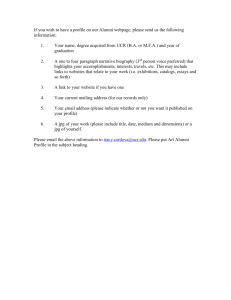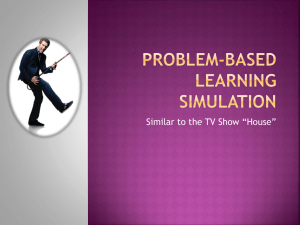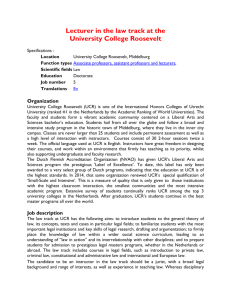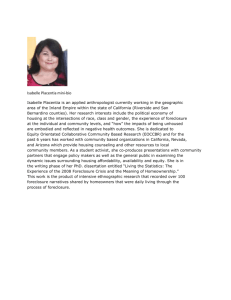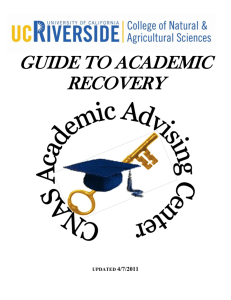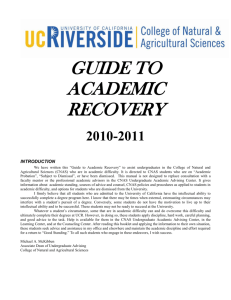Physics & Astronomy - CNAS Undergraduate Academic Advising
advertisement
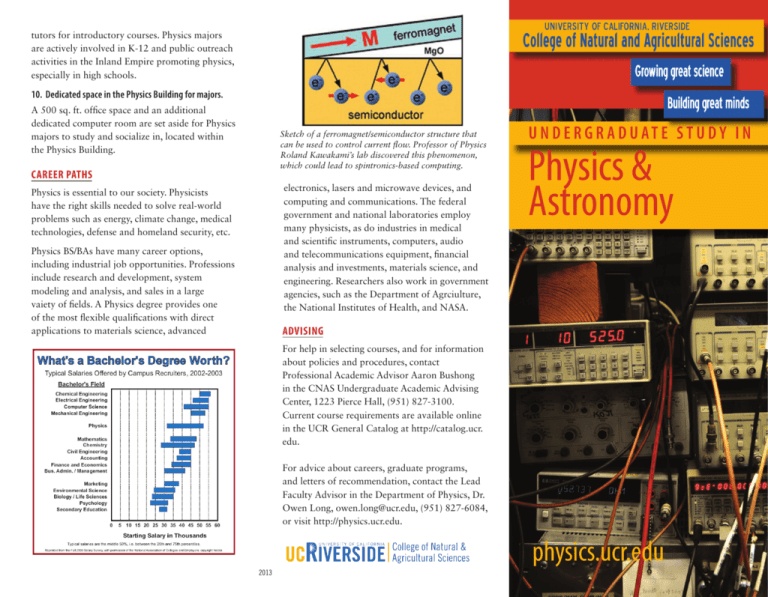
tutors for introductory courses. Physics majors are actively involved in K-12 and public outreach activities in the Inland Empire promoting physics, especially in high schools. 10. Dedicated space in the Physics Building for majors. A 500 sq. ft. office space and an additional dedicated computer room are set aside for Physics majors to study and socialize in, located within the Physics Building. Sketch of a ferromagnet/semiconductor structure that can be used to control current flow. Professor of Physics Roland Kawakami’s lab discovered this phenomenon, which could lead to spintronics-based computing. CAREER PATHS electronics, lasers and microwave devices, and computing and communications. The federal government and national laboratories employ many physicists, as do industries in medical and scientific instruments, computers, audio and telecommunications equipment, financial analysis and investments, materials science, and engineering. Researchers also work in government agencies, such as the Department of Agrciulture, the National Institutes of Health, and NASA. Physics is essential to our society. Physicists have the right skills needed to solve real-world problems such as energy, climate change, medical technologies, defense and homeland security, etc. Physics BS/BAs have many career options, including industrial job opportunities. Professions include research and development, system modeling and analysis, and sales in a large vaiety of fields. A Physics degree provides one of the most flexible qualifications with direct applications to materials science, advanced U N D E R G R A D U AT E S T U D Y I N Physics & Astronomy ADVISING For help in selecting courses, and for information about policies and procedures, contact Professional Academic Advisor Aaron Bushong in the CNAS Undergraduate Academic Advising Center, 1223 Pierce Hall, (951) 827-3100. Current course requirements are available online in the UCR General Catalog at http://catalog.ucr. edu. For advice about careers, graduate programs, and letters of recommendation, contact the Lead Faculty Advisor in the Department of Physics, Dr. Owen Long, owen.long@ucr.edu, (951) 827-6084, or visit http://physics.ucr.edu. physics.ucr.edu 2013 Physics and Astronomy at the University of California, Riverside PHYSICS AND ASTRONOMY The study of physics and astronomy seeks greater understanding of the origin and structure of the universe, and the basic interactions that govern it. It also seeks atomic- and molecularscale understanding of condensed and biological material systems. The goal of UCR’s Department of Physics and Astronomy is to lead research efforts in several subfields of physics and astronomy and to infuse that research into undergraduate and graduate education. In doing so, we seek to provide the nucleus of interaction between materials, biological, and environmental science and engineering researchers at UCR. 10 REASONS TO MAJOR IN PHYSICS & ASTRONOMY AT UCR 1. Get to know the faculty and each other well. UCR Department of Physics & Astronomy has 30 faculty and 25-30 freshman majors in the department: small class sizes, more access to faculty, closer interaction with each other. 2. Learn to think like a scientist from excellent faculty who are creating new science every day. All Physics lecture courses are taught by ladderrank faculty who bring their passion for physics to the classroom. 3. Learn to create new knowledge with extraordinary access to undergraduate research. Seventy percent of graduating UCR Physics majors have performed undergraduate research with our faculty either on campus or off campus (e.g., at CERN). 4. Have a faculty advisor from Day One. The department has five faculty advisors prepared to help students at each stage of their education — from getting the right courses freshman year to career planning and graduate school applications senior year. CNAS college staff advisors keep students on track for graduation and provide all other advising services. 5. Flexible BA/BS options. • Biophysics Track • Physics Education Track 6. UC System and Astronomy advantages. Students and faculty have unique opportunities to access the UC telescopes (Lick and Keck observatories ) and to participate in UC-Lab collaborations with Lawrence Livermore National Laboratory, Los Alamos National Laboratory, and Lawrence Berkeley National Lab. 7. Other UCR and UC System advantages. Students have an option to participate in UC Education Abroad programs with 140 institutions worldwide and UCDC programs (study in Washington, D.C.). 8. UCR Chapter of the Society of Physics Students. Students actively participate in the national SPS organization, which provides opportunities for student leadership, organizing events, and shaping undergraduate education for Physics majors. The department offers four tracks for majors: 9. Opportunities for teaching, tutoring, outreach, and community service. • Standard Physics Track • Applied Physics and Engineering Track The department offers paid positions as student instructors for introductory physics courses and
